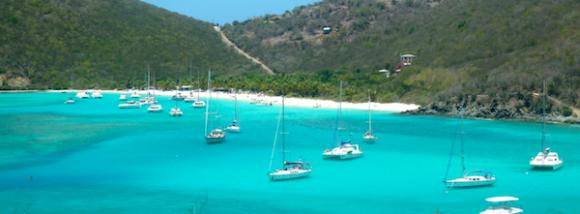 Unless you happened to be very wealthy, hiding out on a boat may not be the best strategy during a pandemic. While billionaires may be able to jet off to their yachts in the Grenadines, the merely comfortable may find themselves stuck with limited ports of call and few options. Across the Caribbean, the South Pacific and even on the East Coast, boaters are discovering ports closed to new arrivals or subject to new regulations that seem to change day-to-day.
Unless you happened to be very wealthy, hiding out on a boat may not be the best strategy during a pandemic. While billionaires may be able to jet off to their yachts in the Grenadines, the merely comfortable may find themselves stuck with limited ports of call and few options. Across the Caribbean, the South Pacific and even on the East Coast, boaters are discovering ports closed to new arrivals or subject to new regulations that seem to change day-to-day.
One of the few safe havens in the Caribbean currently is the U.S. Virgin Islands. A letter signed by the island’s governor, Albert Bryan Jr, in late March says, “I want to welcome you to our US Territory at this time of great world pandemic crisis. Whether you have visited regularly in the past or if this is a first visit, we are pleased to be able to extend to you a safe haven under US Flag protection at this grave time.”
The U.S. Virgin Islands — made up of St. Thomas, St. John, St. Croix and Water Island — have long been popular with boaters, but now things are getting crowded. Instead of the usual 270 boats on moorings or at anchor in islands, they have recently had around 600.
There are real concerns about handling trash and pollution. The New York Times reports that Nate Fletcher, a St. John resident and the owner of Blue Line Yacht Charters (which has not had an onboard guest in more than a month), now goes twice a week, boat to boat, collecting trash. He gathered 60 bags on Tuesday.
“It’s a big career change,” Mr. Fletcher said with a laugh, adding that his boat, the Poseidon, a 37-foot Midnight Express with three 300-horse power engines, is “a very, very fast trash boat.” The $5-a-bag charge does not yield a profit, but it allows him to stay even with his bills, while helping resolve what was “quickly becoming a problem,” he said.
There are also no pumpout stations in St. John, so any boater wishing to pump out a holding tank must take the boat at least three miles offshore to discharge. Some boaters have not been following the rules and are reported to be pumping sewage overboard from the anchorage, raising worries about the impact on water quality.
There is also the concern that the virus will be more widely spread on the islands which lack hospital beds to cope. Local health officials project more than 20,000 infections and upward of 100 hospitalizations if people abide by the strictest measures. But with looser rules, hospitalizations would rocket up to almost 1,000 “at any one point in time,” Dr. Esther Ellis, the territorial epidemiologist said by email.
How long the fleet of new arrivals will be staying is unclear. Hurricane season begins in June. Many boat owners have insurance policies requiring them to leave the Caribbean by June or July. Many would typically hire crew members to help with the journey back, but cannot easily do so under pandemic conditions.
One solution is the “Homeward Bound Flotilla,” an organized departure of boats leaving every Sunday for at least a month. The first nine boats left on Easter.
Salty Dawg Sailing Association, a nonprofit which typically organizes social boating trips, has set up resources to help the passage, waiving its typical fees. Mariners joining the flotilla may access a U.S. Coast Guard interface, an online journey-tracker, and weather updates. The Salty Dawg communicates with authorities and helps troubleshoot closed ports en route. Approximately 160 boats have registered so far; most are stationed in the territory and will head out over the next month.

I can visualise a maritime game of musical chairs where, as a boat in a prime spot ups anchor to go offshore to pump out all the other boats will be bumping onto each other trying to get their anchor down in the location first.
I hope they are not destroying the seabed ecosystem in the process. Mooring buoys are a better solution but it needs organisation to pay for the buoys, their maintenance and collecting mooring fees.
The photo posted with this article appears to be from White Bay, BVI, not from USVI. Water quality tests have recently been performed in many beaches on St John. All locations had good water quality results. Perhaps interviewing folks who are on one of these boats would be helpful.